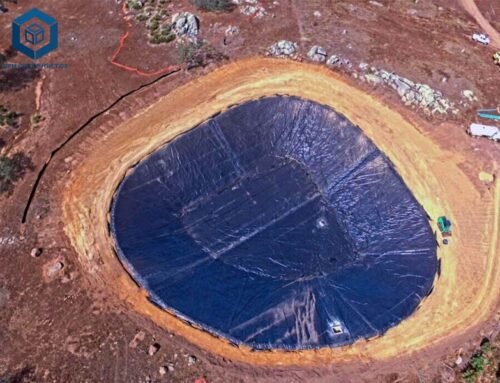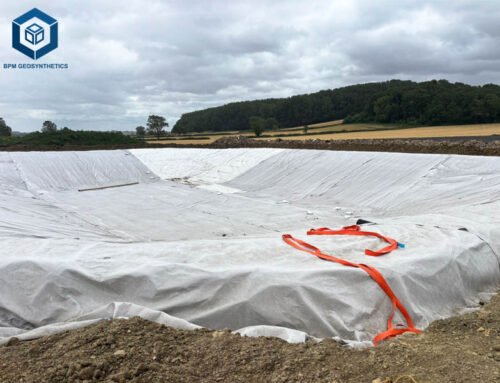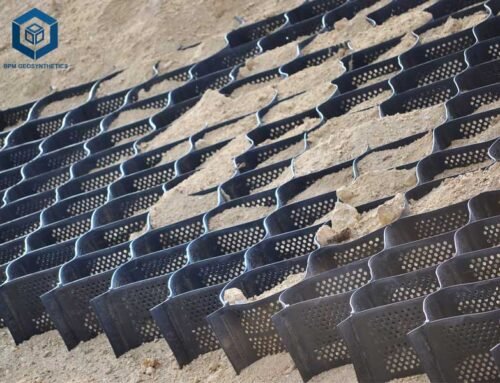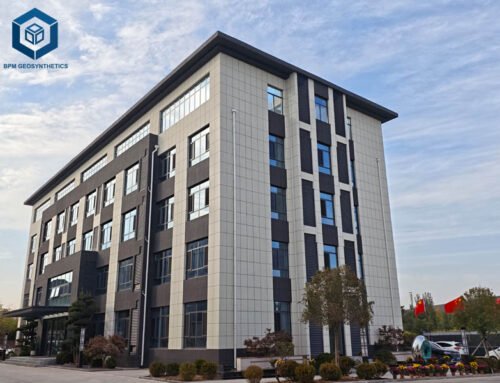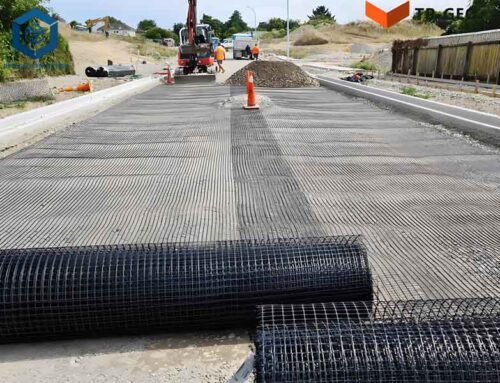Geomembranes are critical components in modern engineering, offering robust solutions for containment, environmental protection, and water management. As industries like mining, waste management, and agriculture increasingly rely on these synthetic liners, understanding their properties, types, and applications is essential for selecting the right material for your project. This comprehensive guide delves into the world of geomembranes, providing detailed insights, specifications, and data-driven comparisons to help you make informed decisions. Whether you’re a contractor, engineer, or project manager, this article will equip you with the knowledge to choose the best geomembrane for your needs.
1. What Is A Geomembrane?
A geomembrane is a synthetic, impermeable membrane used as a liner or barrier in civil and environmental engineering projects to prevent the migration of liquids, gases, or contaminants. Made from polymeric materials, geomembranes are designed to provide durable, long-lasting solutions for applications such as landfills, reservoirs, mining operations, and wastewater treatment facilities. Their primary function is to act as a barrier, ensuring containment and protecting the environment from potential pollution.
Geomembranes are typically manufactured in large rolls, with thicknesses ranging from 20 to 120 mils (0.5 to 3 mm) and widths up to 22.5 feet (6.9 meters). They are installed on-site, often requiring skilled technicians to ensure proper welding or seaming for a leak-proof barrier. According to the Geosynthetic Institute (GSI), geomembranes are a subset of geosynthetics, which also include geotextiles, geogrids, and geocomposites, but geomembranes are distinguished by their low permeability, typically less than 1×10⁻¹⁷ cm/s.
1.1 Applications of Geomembranes
Geomembranes serve a wide range of industries due to their versatility and impermeability. Key applications include:
- Landfill Liners and Caps: Preventing leachate from contaminating groundwater in municipal and hazardous waste landfills.
- Mining: Containing acidic leachate in heap leach pads and tailings impoundments.
- Water Management: Lining reservoirs, canals, and ponds to minimize seepage and ensure efficient water storage.
- Aquaculture: Protecting fish and shrimp ponds from water loss and contamination.
- Wastewater Treatment: Lining lagoons and treatment ponds to contain industrial or municipal waste.
- Construction: Waterproofing foundations, tunnels, and underground structures.
The global geomembrane market is projected to grow from $2.3 billion in 2023 to $3.7 billion by 2030, driven by increasing demand for environmental protection and water conservation solutions. This growth underscores the importance of understanding geomembrane specifications and selecting the right type for specific project requirements.
2. Key Features of Best Geomembrane
Geomembranes are engineered to meet stringent performance criteria, ensuring durability, flexibility, and resistance to environmental stressors. Below are the key features that make geomembranes indispensable for containment applications, supported by technical specifications and data.
Impermeability
The hallmark of a geomembrane is its low permeability, which prevents the passage of liquids and gases. For instance, HDPE geomembranes have a permeability coefficient as low as 1×10⁻¹⁷ cm/s, making them ideal for critical containment projects like landfills and mining operations. This impermeability ensures that hazardous substances, such as leachate from landfills, do not seep into groundwater, protecting both the environment and public health.
Chemical Resistance
Geomembranes must withstand exposure to a variety of chemicals, including acids, alkalis, and hydrocarbons. HDPE geomembranes, for example, are resistant to over 80 chemical compounds, including strong acids and oils, making them suitable for harsh environments like chemical plants and mining sites. PVC geomembranes also offer good chemical resistance but may be less effective against certain corrosive substances compared to HDPE.
UV and Weather Resistance
For exposed applications, such as ponds or reservoirs, geomembranes must resist degradation from ultraviolet (UV) radiation and extreme weather conditions. HDPE geomembranes formulated with carbon black and antioxidants can withstand UV exposure for up to 50 years, while PVC geomembranes are less resistant unless treated with UV stabilizers. LLDPE and LDPE geomembranes also offer UV resistance but are typically used in less demanding applications.
Mechanical Strength
Geomembranes must endure physical stresses during installation and use, such as punctures, tears, and tensile forces. HDPE geomembranes typically have tensile strengths ranging from 3 kN/m to 80 kN/m, with tear resistance between 25 N and 374 N, depending on thickness. LLDPE geomembranes, with their higher elongation capacity (up to 800%), are better suited for applications requiring flexibility over irregular surfaces.
Durability and Longevity
When properly installed, geomembranes can last for decades. HDPE geomembranes, for instance, have a service life of 50 years or more in buried applications, while PVC geomembranes have demonstrated longevity of over 30 years in projects like irrigation canals. Factors such as material formulation, installation quality, and environmental conditions significantly influence durability.
Flexibility and Ease of Installation
Flexibility is crucial for conforming to irregular surfaces or complex geometries. LLDPE and PVC geomembranes are more flexible than HDPE, allowing easier installation in applications like ponds or landscaping projects. However, HDPE’s rigidity can be advantageous in high-stress environments, as it reduces the risk of deformation under load.
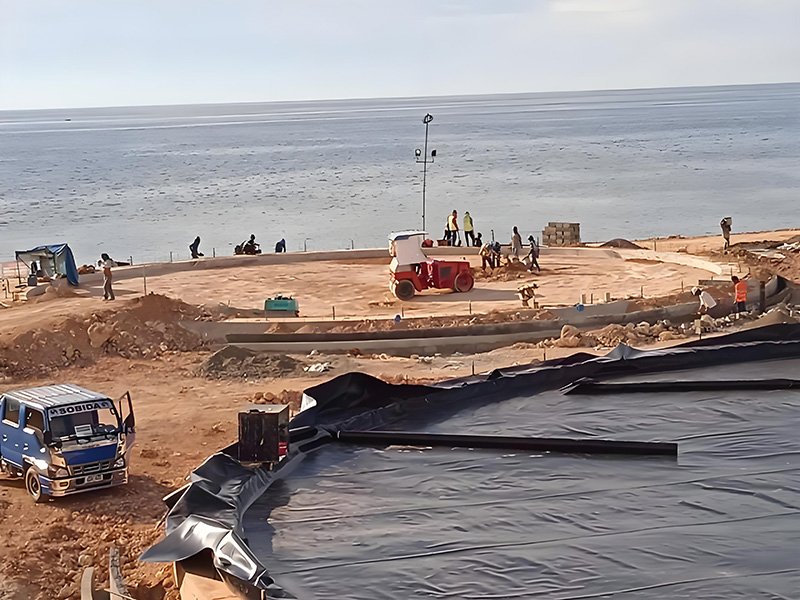
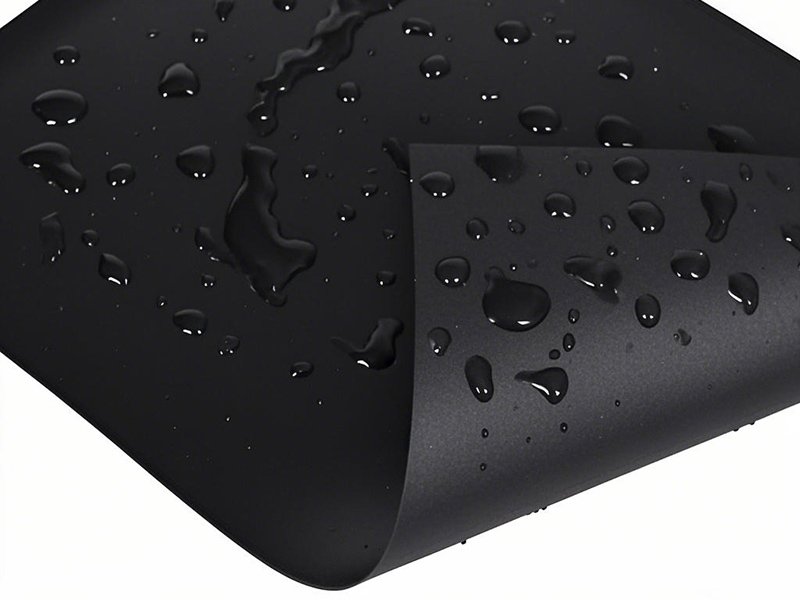
3. What Are Types of Geomembrane?
Geomembranes are classified based on their material composition, with each type offering unique properties suited to specific applications. The most common types are High-Density Polyethylene (HDPE), Low-Density Polyethylene (LDPE), Linear Low-Density Polyethylene (LLDPE), Polyvinyl Chloride (PVC), and Ethylene Propylene Diene Monomer (EPDM). Below is an overview of each type, including their specifications and typical uses.
High-Density Polyethylene (HDPE)
- Density: 0.934–0.938 g/cm³ (medium-density range, often mislabeled as HDPE).
- Thickness: 20–100 mils (0.5–2.5 mm).
- Key Properties: High tensile strength (3–80 kN/m), excellent chemical resistance, UV stability with carbon black, and low permeability (1×10⁻¹⁷ cm/s).
- Applications: Landfill liners, mining heap leach pads, wastewater lagoons, and reservoirs.
- Advantages: Durable, cost-effective, and resistant to harsh chemicals and UV exposure. HDPE is the most widely used geomembrane globally, accounting for over 50% of the market share due to its versatility and compliance with standards like GRI-GM13.
- Limitations: Less flexible than LLDPE or PVC, requiring on-site welding, which can be labor-intensive when installing HDPE Geomembrane.
Low-Density Polyethylene (LDPE)
- Density: 0.916–0.930 g/cm³.
- Thickness: 20–80 mils (0.5–2 mm).
- Key Properties: High flexibility, good puncture resistance, and low-temperature resistance (down to -70°C).
- Applications: Temporary liners, pond liners, and aquaculture.
- Advantages: Easy to install, lightweight, and cost-effective for short-term or less demanding applications.
- Limitations: Lower strength and chemical resistance compared to HDPE, making it unsuitable for critical containment projects.
Linear Low-Density Polyethylene (LLDPE)
- Density: 0.915–0.925 g/cm³.
- Thickness: 20–120 mils (0.5–3 mm).
- Key Properties: Superior flexibility (elongation up to 800%), UV resistance, and stress crack resistance.
- Applications: Eff Efluent ponds, stormwater collection, and landfill caps.
- Advantages: Easier to install over irregular surfaces, can be prefabricated, reducing field seaming.
- Limitations: Less puncture-resistant than HDPE, with a shorter lifespan in harsh environments.
Polyvinyl Chloride (PVC)
- Density: 1.2–1.4 g/cm³.
- Thickness: 10–60 mils (0.25–1.5 mm).
- Key Properties: High flexibility, good chemical resistance, and low cost.
- Applications: Decorative ponds, irrigation canals, and secondary containment systems.
- Advantages: Easy to install, lightweight, and suitable for low-temperature environments. PVC has been used successfully for over 36 years in waste containment.
- Limitations: Susceptible to UV degradation and plasticizer migration, which can reduce longevity unless stabilized.
Ethylene Propylene Diene Monomer (EPDM)
- Density: 1.1–1.2 g/cm³.
- Thickness: 30–60 mils (0.75–1.5 mm).
- Key Properties: High flexibility, excellent UV resistance, and durability in exposed conditions.
- Applications: Ponds, canals, and decorative water features.
- Advantages: Ideal for exposed applications due to its weather resistance and ease of installation.
- Limitations: Higher cost and lower chemical resistance compared to HDPE, limiting its use in industrial applications.
4. Key Differences of HDPE vs LDPE vs LLDPE vs PVC Geomembrane
Choosing the right geomembrane requires understanding the differences between HDPE, LDPE, LLDPE, and PVC. The table below summarizes their key properties, followed by a detailed comparison.
| Property | HDPE | LDPE | LLDPE | PVC |
| Density (g/cm³) | 0.934–0.938 | 0.916–0.930 | 0.915–0.925 | 1.2–1.4 |
| Tensile Strength (kN/m) | 3–80 | 2–20 | 5–50 | 2–30 |
| Elongation (%) | 400–700 | 600–800 | 700–800 | 200–400 |
| Permeability (cm/s) | 1×10⁻¹⁷ | 1×10⁻¹⁵ | 1×10⁻¹⁶ | 1×10⁻¹² |
| UV Resistance | Excellent (with carbon black) | Moderate | Good | Moderate (requires stabilizers) |
| Chemical Resistance | Excellent (80+ chemicals) | Moderate | Good | Good (limited for some chemicals) |
| Flexibility | Low | High | Very High | High |
| Service Life (years) | 50+ | 10–20 | 20–30 | 20–30 |
| Cost | Moderate | Low | Moderate | Low |
Detailed Comparison of Best Geomembrane Types
- Strength and Durability: HDPE geomembranes offer the highest tensile strength and puncture resistance, making them ideal for high-stress applications like landfill liners and mining operations. LDPE and LLDPE have lower tensile strengths but provide greater flexibility, while PVC’s strength is adequate for less demanding applications.
- Flexibility: LLDPE and PVC are the most flexible, allowing them to conform to irregular surfaces without requiring extensive seaming. LDPE is also flexible but less durable, while HDPE’s rigidity can complicate installation in complex terrains.
- Chemical Resistance: HDPE excels in resisting a wide range of chemicals, including strong acids and hydrocarbons, making it the preferred choice for industrial applications. PVC and LLDPE offer good chemical resistance but are less effective in highly corrosive environments. LDPE has the lowest chemical resistance.
- UV and Weather Resistance: HDPE and LLDPE, when formulated with UV stabilizers, perform well in exposed conditions. PVC requires additional stabilizers to prevent UV degradation, while LDPE is less suitable for long-term exposure.
- Cost and Installation: PVC and LDPE are generally the most cost-effective options, with easier installation due to their flexibility. HDPE, while slightly more expensive, offers long-term cost savings due to its durability. LLDPE strikes a balance between cost and performance.
- Environmental Impact: HDPE is recyclable and considered environmentally friendly, reducing waste at the end of its service life. PVC’s plasticizers can pose environmental concerns if not properly stabilized, while LDPE and LLDPE are also recyclable but less commonly used in critical applications.
Choosing the Right Material
The choice between HDPE, LDPE, LLDPE, and PVC depends on project-specific factors such as environmental conditions, budget, and application requirements. For example, HDPE is the go-to choice for landfills and mining due to its durability, while PVC and LLDPE are preferred for ponds and canals due to their flexibility and ease of installation.
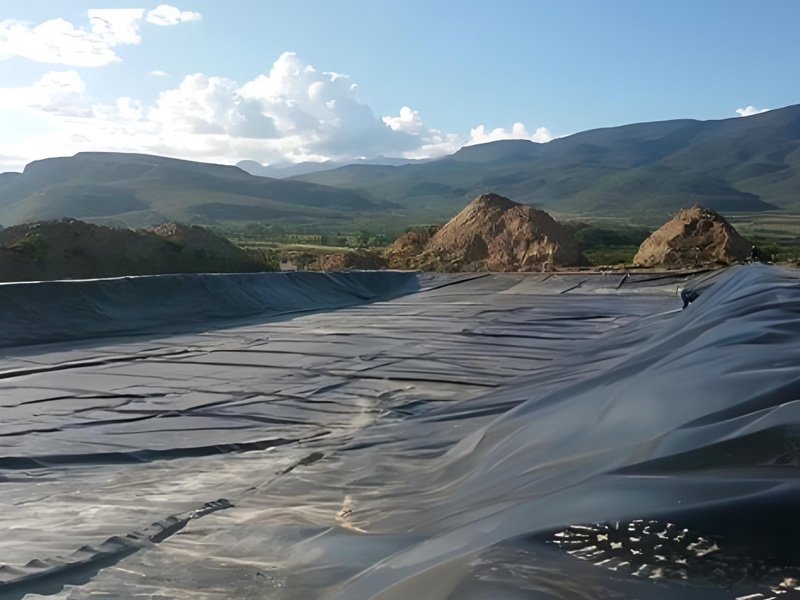
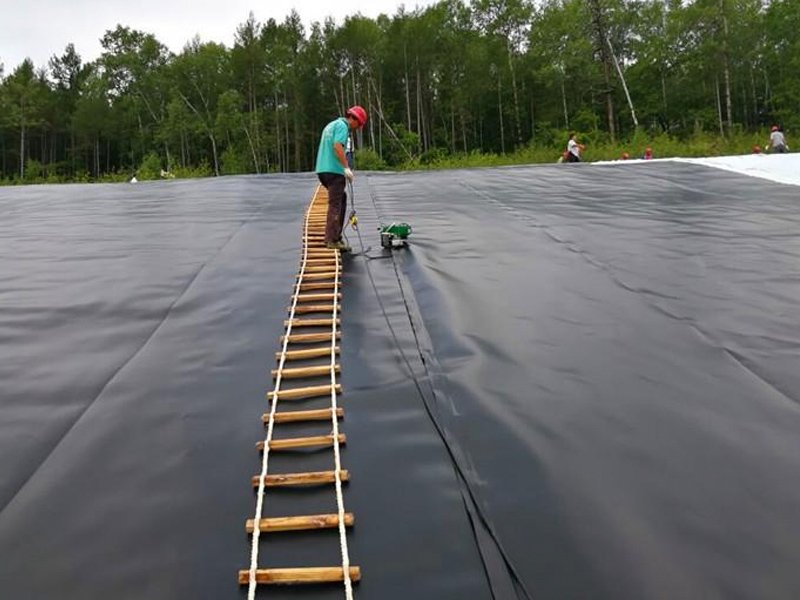
5. Is Geomembrane Effective for Anti-Seepage Water Containment?
Geomembranes are highly effective for anti-seepage water containment, making them a cornerstone of water management and environmental protection projects. Their low permeability ensures minimal water loss, while their durability protects against leaks and contamination. Below are key points demonstrating their effectiveness, supported by data and real-world applications.
Effectiveness in Water Containment
- Low Permeability: HDPE geomembranes, with a permeability coefficient of 1×10⁻¹⁷ cm/s, are virtually impermeable, making them ideal for reservoirs, canals, and ponds. For instance, lining irrigation canals with HDPE can reduce seepage losses by up to 95%, improving water delivery efficiency.
-IReal-World Success: The U.S. Bureau of Reclamation has used PVC geomembranes in irrigation canals for over 30 years, reporting no significant pinholes or leaks in properly installed systems. Similarly, HDPE liners in municipal landfills have prevented groundwater contamination for decades. - Versatility: Geomembranes are used in diverse water containment applications, from aquaculture ponds to industrial wastewater lagoons. LLDPE liners, for example, are effective in effluent ponds due to their flexibility and ability to handle differential settlement.
Case Studies
- Landfill Liners: In the U.S., EPA regulations mandate composite liner systems (geomembrane over clay) for municipal solid waste landfills. HDPE geomembranes, with thicknesses of 60–80 mils, have been shown to reduce leachate seepage to less than 1 liter per hectare per day.
- Mining Applications: In gold mining, HDPE liners beneath heap leach pads prevent acidic leachate from polluting groundwater. A study by the Geosynthetic Institute found that 80-mil HDPE liners withstood highly acidic conditions (pH < 2) for over 20 years without significant degradation.
- Water Reservoirs: In arid regions, HDPE-lined reservoirs have reduced water loss by up to 90% compared to unlined systems, ensuring efficient storage for irrigation and drinking water.
Challenges and Solutions
While geomembranes are highly effective, improper installation or material selection can compromise performance. Common challenges include:
- Punctures and Tears: Sharp subgrade materials can damage liners during installation. Using a geotextile underlay or ensuring proper subgrade preparation mitigates this risk.
- Seam Failures: Poor welding or seaming can lead to leaks. Certified technicians using hot wedge or extrusion welders ensure high-quality seams, with HDPE welds often stronger than the material itself.
- UV Degradation: For exposed applications, UV-resistant formulations (e.g., HDPE with carbon black) are critical to maintaining performance.
By addressing these challenges through proper design and installation, geomembranes provide reliable, long-term anti-seepage solutions.
6. Main Considerations When Choosing Best Geomembrane
Selecting the right geomembrane involves evaluating project-specific requirements, environmental conditions, and budget constraints. Below are the main considerations, supported by technical insights and industry standards.
Project Requirements
- Application Type: Determine whether the geomembrane will be used for landfill containment, water storage, or industrial waste management. HDPE is preferred for high-stress applications, while LLDPE or PVC suits flexible, low-cost projects.
- Containment Needs: For hazardous waste or chemical containment, prioritize chemical resistance (e.g., HDPE). For decorative ponds, flexibility and aesthetics (e.g., PVC or EPDM) may take precedence.
Environmental Conditions
- Chemical Exposure: Assess the types of chemicals the geomembrane will encounter. HDPE’s resistance to over 80 chemicals makes it ideal for mining and industrial applications.
- UV and Weather Exposure: For exposed applications, choose UV-stabilized materials like HDPE or EPDM. Buried applications require less UV resistance but demand durability against soil stresses.
- Temperature Range: HDPE and LLDPE operate effectively from -60°C to +80°C, while PVC performs well in cold climates but may degrade at high temperatures.
Site Conditions
- Subgrade Quality: Rough or rocky subgrades require thicker geomembranes (e.g., 60–80 mil HDPE) or protective geotextiles to prevent punctures.
- Topography: Slopes steeper than 6H:1V may require textured HDPE for better friction and stability, while flat terrains can use smoother, more flexible materials like LLDPE.
Installation and Maintenance
- Installation Complexity: Flexible materials like LLDPE and PVC are easier to install, reducing labor costs. HDPE requires on-site welding, which demands skilled technicians.
- Maintenance Needs: HDPE’s durability minimizes maintenance, while PVC may require periodic inspections for plasticizer migration or UV degradation.
Budget and Cost-Effectiveness
- Initial Cost: PVC and LDPE are generally cheaper than HDPE or LLDPE, but their shorter lifespan may increase long-term costs. HDPE’s higher initial cost is offset by its 50+ year service life.
- Total Cost of Ownership: Consider maintenance, repair, and replacement costs. HDPE’s durability often makes it more cost-effective over time.
Regulatory Compliance
- Industry Standards: Ensure the geomembrane meets standards like GRI-GM13 (HDPE), GRI-GM17 (LLDPE), or ASTM D7176 (PVC). These standards specify minimum requirements for tensile strength, puncture resistance, and permeability.
- Environmental Regulations: For landfill or mining projects, compliance with EPA or local regulations may mandate specific materials (e.g., HDPE for landfill liners).
Sustainability
- Recyclability: HDPE and LLDPE are recyclable, reducing environmental impact at the end of their service life. PVC’s plasticizers may pose disposal challenges unless stabilized.
- Environmental Impact: Choose materials that minimize ecological harm, such as HDPE, which is non-toxic and safe for groundwater protection.
7. Final Thoughts
Geomembranes are indispensable tools for modern engineering, offering reliable solutions for anti-seepage, containment, and environmental protection. HDPE stands out as the most durable and versatile option, excelling in high-stress applications like landfills and mining. LLDPE and PVC offer flexibility and cost-effectiveness for less demanding projects, while LDPE suits temporary or low-risk applications. EPDM is ideal for exposed, decorative water features.
When selecting the best geomembrane, consider project requirements, environmental conditions, site characteristics, installation feasibility, budget, and regulatory compliance. Data-driven decisions, supported by standards like GRI-GM13 and ASTM, ensure optimal performance and longevity. For critical projects, consulting with geosynthetic experts and certified installers is crucial to achieving a leak-proof, durable containment system.
By understanding the properties, applications, and trade-offs of HDPE, LDPE, LLDPE, PVC, and EPDM geomembranes, you can confidently choose the right material for your project, ensuring environmental protection, cost-effectiveness, and long-term success. For further guidance, contact reputable manufacturers like BPM Geosynthetics for tailored solutions and technical support.

